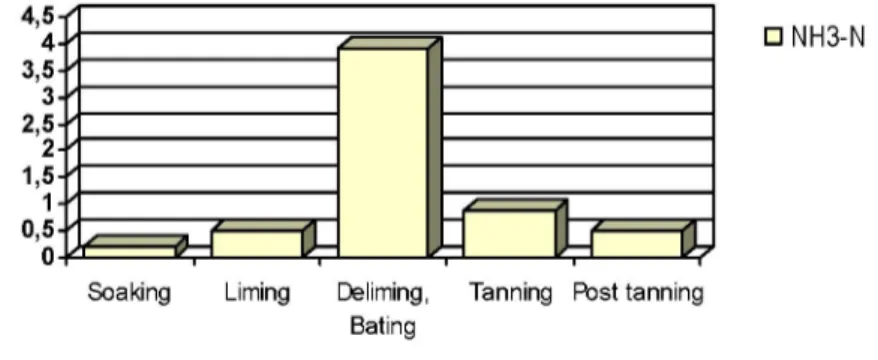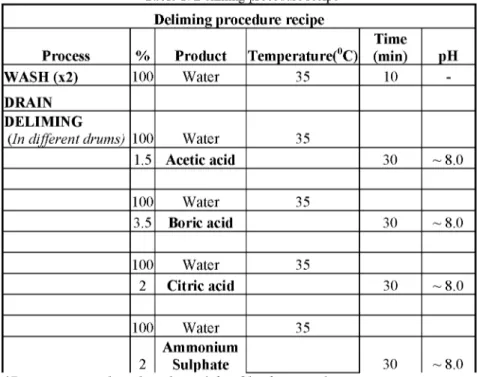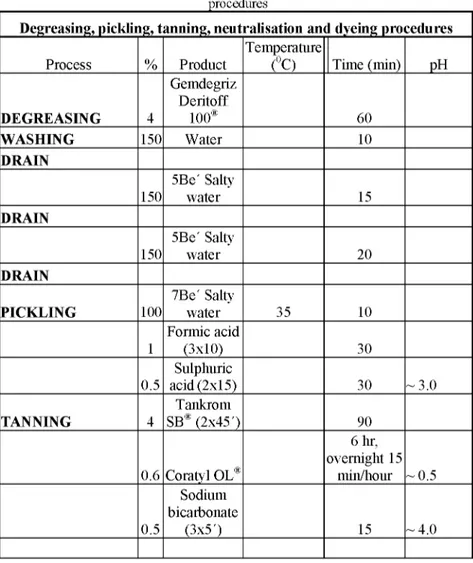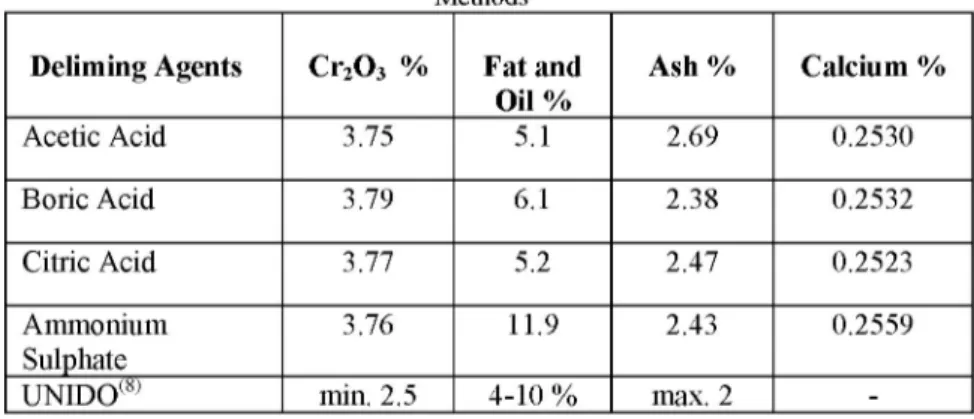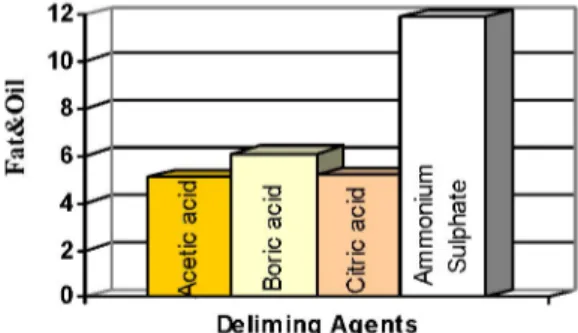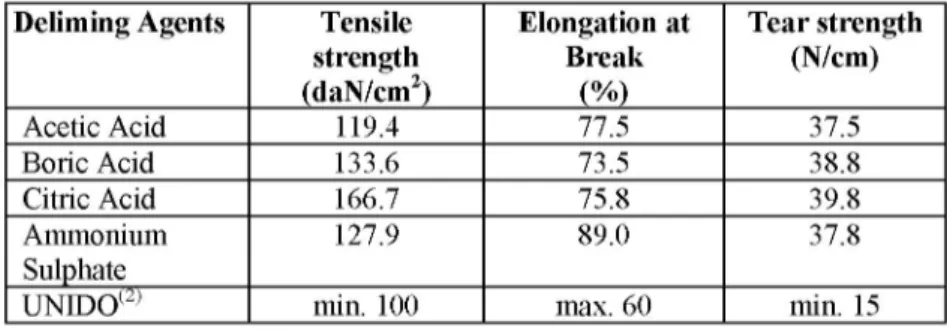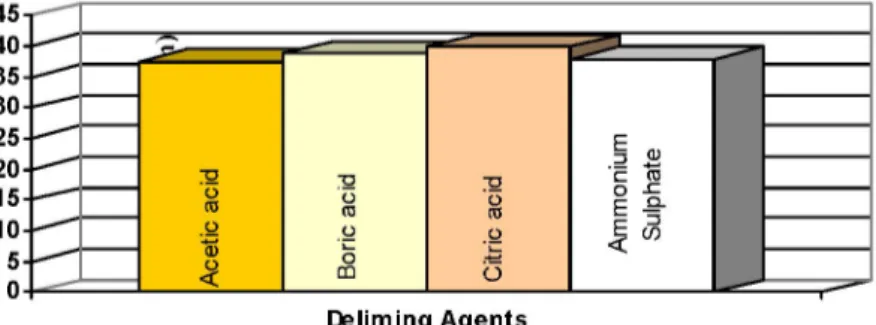THE APPLICATION OF DIFFERENT DELIMING
AGENTS FOR DECREASING AMMONIUM
POLLUTION LOAD CAUSED BY DELIMING
OPERATION IN LEATHER INDUSTRY AND
THE EFFECTS OF THESE DELIMING AGENTS
ON LEATHER QUALITY AND EFFLUENT
POLLUTION LOAD
Selime MENTEŞ ÇOLAK Eylem KILIÇ
selime.mentes.colak@ege.edu.tr eylemkilic@gmail.com Ege Üniversitesi Mühendislik Fakültesi Deri Mühendisliği Bölümü,
Bornova/İZMİR - TURKEY
ABSTRACT
Effluent which has a high content of ammonium load is produced as a result of traditional deliming operation during the leather production. In this operation, ammonium salts are being used. Among the production processes the highest rate of ammonium content is originated from the traditional deliming operation. The NH3 in water is a source of pollution. Ammonia is converted into nitrate by
means of nitrogen cycle in nature. The ammonium discharged into natural water sources has toxic effects on living organisms.
In this research by application of weak acids studies on sheep skins were made to reduce the ammonium load that originated from deliming operation. Beside the deliming effect of acids, N content of the resulting discharge water was determined and the effect of these methods on the quality of the leather was studied. The data obtained from the study were compared with the traditional deliming methods and standards.
Key Words: leather, deliming, weak acid, ammonium salts, environment
ÖZET
Deri üretimi sırasında geleneksel kireç giderme işlemi sonucunda amonyum içeriği yüksek atık sular ortaya çıkar. Bu yöntemde genellikle amonyum tuzları
kullanılmaktadır. Üretim prosesleri sırasında en yüksek amonyum içeriği geleneksel kireç giderme işleminden kaynaklanmaktadır. Sulardaki NH3 konsantrasyonları önemli bir kirlilik kaynağıdır. Amonyak doğadaki azot çevriminde nitrata dönüşür. Doğal sulara deşarj edilen amonyum canlılar için zehir etkisine sahiptir. Araştırmada, kireç giderme işleminden kaynaklanan amonyum yükünü azaltmak için farklı asitler kullanılarak çalışmalar yapılmıştır. Çalışmada asitlerin kireç giderici etkisinin yanında, işlem sonucu ortaya çıkan atık suların N içerikleri tespit edilmiş ve bu yöntemlerin derilerin kalitesi üzerine etkisi araştırılmıştır. Çalışmada elde edilen veriler, geleneksel kireç giderme yöntemleriyle ve standartlarla karşılaştırılmıştır.
Anahtar Kelimeler: deri, kireç giderme, zayıf asit, amonyum tuzları, çevre
1. INTRODUCTION
In leather production the process of liming, is performed for removing the epidermal structure, opening up fibrillar structure by swelling, and forming active carboxyl and amino groups with which chemicals given in tanning and following processes, can bond to leather. During liming process pH of leather is raised to 12-13. At the end of this process pH value of leathers have to be reduced by deliming process to a pH level at which bating process can be performed. Ammonium salts are commonly used in deliming processes around the world.
Ammonium salts are the most commonly used deliming agents because they quickly penetrate into the hide and have a buffering action regulates the pH at optimal values and penetrating quickly(5). In recent years due to environmental
problems limitation of ammonium salts used in deliming process is required(3).
The ammonium ions contained in tannery effluent are mainly generated at the deliming and bating stages. It is often very difficult and expensive to remove them in effluent treatment plants(16).
Up to 70% of the ammonia ions discharged in tannery effluent is the result of the use of ammonium sulfate in the deliming and bating preparations(6). The
ammonium loads discharged in effluents from individual leather processing operations are presented in Figure 1(7).
The reduction of ammonium load in leather industry effluents is environmentally important. Beside being expensive and time-consuming the treatment of these effluents is toxic and hazardous for environment. The deliming phase using ammonium salts bring about considerable nitrogen pollution, estimated to be as much as 40% of total discharge(1). The 13.5% of
effluent in the form of ammonia nitrogen and 13.5% is emitted into air as ammonia gas. This gas is toxic and may pose risk for the health and safety of workers(15). 4,5 n 4- 3,5- 3- 2,5- 2- 1,5- 1- 0,5-• NH3-N S o a k i n g Liming Deliming, B a t i n g T a n n i n g Post t a n n i n g
Figure 1: Discharged ammonium load from individual leather processing operations
Nitrification caused by high ammonium content increases biological oxygen demand of effluents. Leaking of these effluents into the streams may cause fish and other aquatic living organism to die.
Boric acid, magnesium lactate, organic acids such as lactic acid, formic acid and acetic acid or esters of organic acids can be used to substitute ammonium salts. When used in deliming process weak acids provide some advantages. The most important one is they penetrate easily and fast into the skin owing to having non-swelling effect. Positive effects on the quality of the pelts are observed when used in deliming process(4). In this study various weak acids
and conventional deliming agent ammonium sulphate was used. The nitrogen content of effluents from deliming process was determined. The quality of the pelts processed according to these methods was determined by chemical and physical tests. The values obtained were compared with standards and leathers produced by conventional deliming process.
2. MATERIAL AND METHOD
MATERIAL
The study was conducted on salt-dried domestic sheep skins and the number of skins used was 3. Deliming processes of skins were carried out by using four different deliming agents like acetic acid (99.8%, technical grade), boric acid (99.5%, analytical grade), citric acid (99.5%, analytical grade) and ammonium sulphate. All experiments were done in triplet and laboratory-scale drums were used.
METHOD
Following soaking, unhairing and liming processes sheep skins were split into four pieces of equal size and each piece was delimed with a different deliming agent. The pH of deliming float was determined as 13.0. Deliming procedure is presented in Table 1.
Table 1: Deliming procedure recipe Deliming procedure recipe
Process % Product Temperature(0C)
Time
(min) pH
WASH (x2) 100 Water 35 10
DRAIN DELIMING
(In different drums) 100 Water 35
1.5 Acetic acid 30 ~ 8.0 100 Water 35 3.5 Boric acid 30 ~ 8.0 100 Water 35 2 Citric acid 30 ~ 8.0 100 Water 35 2 Ammonium Sulphate 30 ~ 8.0
Afterwards samples were taken from the deliming float and total nitrogen (N) content of effluents were measured photometrically by using test kits and Merck SQ 300 device.
Skins were processed into leathers according to the following recipe (Table 2) after the deliming and bating processes.
Table 2: The recipe of degreasing, pickling, tanning, neutralisation and dyeing
procedures
Degreasing, pickling, tanning, neutralisation and dyeing procedures
Process % Product Temperature (0C) Time (min) pH DEGREASING 4 Gemdegriz Deritoff 100® 60 WASHING 150 Water 10 DRAIN 150 5Be' Salty water 15 DRAIN 150 5Be' Salty water 20 DRAIN PICKLING 100 7Be' Salty water 35 10 1 Formic acid (3x10) 30 0.5 Sulphuric acid (2x15) 30 ~ 3.0 TANNING 4 Tankrom SB® (2x45') 90 0.6 Coratyl OL® 6 hr, overnight 15 min/hour ~ 0.5 0.5 Sodium bicarbonate (3x5') 15 ~ 4.0
NEUTRALISATION 150 Water 35 3 Tankrom SB® 40 1 Sodium formate 20 1 Sodium bicarbonate (1:20) (1x3) 45 ~ 5.0 DYEING 60 Water 35 3 DRASiL TX® 15 3 Vandotan AZ® 15 2 Pellutax 385® 15 3 Dye 45 200 Water 70 5 SANDOLIX WWL® 2 GRASSAN PA® 2 PELLASAN MOL® 60 1.5 Formic acid (1:10) (1x3) ~ 3.8 DRAIN WASHING DRYING DRAIN WASHING DRYING DRAIN WASHING DRYING
In order to determine the quality and physical resistance parameters of leathers processed by these methods tests like tensile strength, elongation at break and tear strength were made according to TS.4119(11), TS.4118(10) standards of
Turkish Standards Institution.
Analysis for determination of chromic oxide, sulphated total ash and sulphated water-insoluble ash and matter soluble in dichloromethane in leather were made in accordance with TS.4126(14), TS.4125(13) and TS.4124(12) standards.
Calcium determination was done with calcium filter and acetylene/air mixture using Eppendorf Gerätebau Flame Photometry. Each leather sample was tested in accordance with standard methods in triplets.
3. RESULTS AND CONCLUSION
Nitrogen is found in effluents in the form of ammonia nitrogen, nitrate nitrogen, nitrite nitrogen and organic nitrogen. It is a criterion that must be measured in surface water and contaminated water. The nitrogen content originated from structure of leather and ammonium sulphate used in conventional deliming process is the main source of nitrogen in deliming effluents. Total nitrogen values obtained from the measurement of the effluent samples taken from deliming float were given in Figure 2.
4 5 0 4 0 0 S 3 5 0 S 3 0 0 2 0 0 50 0
Figure 2: Total Nitrogen Values of Deliming Effluents
It is reported that the nitrogen content of leather industry effluents discharged directly into the surface water is must be between 3-10 mg/l(9). Industrial
ammonia nitrogen level of leather industry is given as 83-159 mg/l(8).
As can be seen in Table 3, total nitrogen values are seemed to vary between 17 mg/l and 350 mg/l. According to these values the deliming agent which has the lowest total nitrogen value is citric acid and acetic acid and boric acid has higher values respectively.
Table 3: Total Nitrogen Values of Deliming Effluents
C i t r i c A c i d A c e t i c A c i d B o r i c A c i d A m m o n i u m S u l p h a t e
Deliming Agents Total N (mg/l)
Citric Acid 17
Acetic Acid 60
Boric Acid 80
The highest total nitrogen value among the deliming agents was measured for ammonium sulphate. Though the total nitrogen values of citric acid, acetic acid and boric acid were below the discharge limits, the value of ammonium sulphate is reasonably above the limits.
Table 4: Chemical Analysis Results of Leathers Processed Using Different Deliming
Methods
Deliming Agents Cr2O3 % Fat and
Oil % Ash % Calcium % Acetic Acid 3.75 5.1 2.69 0.2530 Boric Acid 3.79 6.1 2.38 0.2532 Citric Acid 3.77 5.2 2.47 0.2523 Ammonium Sulphate 3.76 11.9 2.43 0.2559 UNIDO(8) min. 2.5 4-10 % max. 2
-The chemical analysis results of leather samples were given in Table 4 and Figure 3, 4, 5. 4 3,5 3 2,5 2 1,5 1 0,5 0 • — E .2 ro jo "O 'c .2 ro ro O O F j i o a £ O O <r w E o a £ m O O -
L J
Deliming agentsFigure 3: Cr2O3 % Content of Leather Samples
There doesn't seem to be significant differences in terms of chromic oxide content of leather samples but the highest value was measured for the leather delimed with boric acid (Figure 3). All leather samples provided values above the 2.5% chromic oxide content sub-limit of acceptable quality levels in leathers that indicated by United Nations Industrial Development Organization, UNIDO(2). Although all processes except deliming-bating were done in the
same float fat and oil analysis results of acetic acid, boric acid, and citric acid are close to each other, the value for ammonium sulphate is slightly above 10% the top-limit of UNIDO(2) (Figure 4). It's thought to be due to taking samples
from different sides of the skin. Because of being a natural material, considerable variation of physical and chemical structure is found in different sides of animal skins.
12 10 o « tu ro o a J A m o 2 o Deliming Agents
Figure 4: Fat&Oil % Content of Leather Samples
As the ash contents of leather samples were examined boric acid delimed leather samples provided the minimum ash% content. Ammonium sulphate and citric acid delimed leathers provided higher ash% contents respectively and acetic acid delimed leather the highest (Figure 5). According to calcium measurements by using Flame Photometry, all values were found to be close to each other and ammonium sulphate delimed leather showed the maximum value. 3,5 3 2,5 2 1,5 1 0,5 0 T3 O ro o a £ m o ¡ Ä §
T
H
I W
Deliming AgentsFigure 5: Ash% content of leather samples
8 6 4
0,3-1 0,25 0,2 0,15 0,1 0,05 0 T3 O ro (U £ m o o o
£
Deliming AgentsFigure 6: Calcium% content of leather samples
Table 5: Physical Test Results of Leathers Processed Using Different Deliming
Methods
Deliming Agents Tensile
strength (daN/cm2) Elongation at Break (%) Tear strength (N/cm) Acetic Acid 119.4 77.5 37.5 Boric Acid 133.6 73.5 38.8 Citric Acid 166.7 75.8 39.8 Ammonium 127.9 89.0 37.8 Sulphate
UNIDO(2) min. 100 max. 60 min. 15
The data obtained from tensile strength, elongation at break and tear strength test which were done in addition to chemical analysis to compare the qualities of leathers, are presented in Figure 7, 8, 9 and Table 5.
200 S 150 .s M H o - S Vi <J eu ¡z « S w o H 100 50 ro o ti 3 "O o ro O Ü Ü2 §
I
H
<Ll
Deliming AgentsFigure 7: Tensile Strength of Leather Samples
s « M S _o w 100 80 60 40 20 0 ^ SE 'c o o ro "O O ro "O O ro 'c SE o JŞ 2 a £ o o m .o O E E <
S
Deliming AgentsFigure 8: %Elongation at Break of Leather Samples
The tensile strength values of leather samples were quite above the acceptable 100 (daN/cm2) sub-limit value. The highest tensile strength value was
observed with citric acid delimed leather. It is thought to be due to the formation of two different buffer systems that prevent unexpected pH changes, so less damage is given to fibers (Figure 7).
Owing to skin structure, the values obtained for elongation at break tests were found to be higher than the elongation top-limit of 60% that indicated by UNIDO(2) (Figure 8).
Tear strength values obtained were quite above the 15 (N/cm) sub-limit. Citric acid delimed samples provided the highest tear strength values (Figure 9). Boric acid showed lower tear strength value than citric acid samples and acetic acid samples showed the lowest value (Table 5).
Deliming Agents
Figure 9: Tear strength values of leather samples
The leather quality specifications obtained by using different acids and ammonium sulphate in deliming process were found to be close to each other.
When nitrogen content sourced by deliming process was examined it was determined that acid delimed samples contained quite less concentrations of nitrogen and especially effluent of citric acid delimed samples had the minimum nitrogen content among other acids.
According to data obtained from this study using acids for decreasing pollution caused by ammonium salts may be suggested.
4. REFERENCES
1. Aloy, M.; Introduction of Cleaner Production Methods-Prospects and Constraints, UNIDO Leather and Leather Products Industry Panel, Nairobi Kenya (1993). 2. Anonymous, Acceptable Quality Levels in Leathers, United Nations Publications,
New York (1976), 43.
3. Bosnic M., Buljan J. and Daniels, R.P.; Pollutants in Tannery Effluents, UNIDO, US/RA/92/120, (2000).
4. European Commission, Integrated Pollution Prevention and Control Reference Document on Best Available Techniques for the Tanning of Hides and Skins, (2003), 115.
5. Ghimenti, D. G.; Clean Technologies in the Tanning Process Life Project., Stoneham (1994), 371-391: http://www.dcci.unipi.it/bea/Conceria-Nuti/inglese/book.html [2006].
6. Kolomaznik, K., Blaha, A., Derdle, T. and Bailey, D.G., Taylor, M.M.; Non-Ammonia Deliming Of Cattle Hides with Magnesium Lactate, JALCA 91, (1996),
18.
7. Ludvik, J., Buljan, J.; The Scope for Decreasing Pollution Load in Leather Processing, UNIDO Regional Programme for Pollution Control in the Tanning Industry in South-East Asia, 51.
8. Patterson, W., J.; Industrial Wastewater Treatment Technology, Butterworth Publishers (1985), 235-255.
9. Springer, H.; Treatment of Industrial Waste of the Leather Industry-Is it Still a Major Problem?, JALCA 89, (1994), 153-182
10. T.S. 4118, Mamul Deriler- Yırtılma Dayanımı Tayini, Türk Standartları Enstitüsü, Ankara (1984).
11. T.S. 4119, Mamul Deriler- Kimyasal Deney Numunelerinin Hazırlanması, Türk Standartları Enstitüsü, Ankara (1984).
12. T.S. 4124, Mamul Deriler- Diklormetanda Çözünen Madde Tayini, Türk Standartları Enstitüsü, Ankara (1984).
13. T.S. 4125, Mamul Deriler- Toplam Sülfat Külü ve Suda Çözünmeyen Sülfat Külü Tayini, Türk Standartları Enstitüsü, Ankara (1984).
14. T.S. 4126, Mamul Deriler- Krom Oksit (Cr2O3) Tayini, Türk Standartları
Enstitüsü, Ankara (1984).
15. United Nations Environment Programme Industry And Environment, Cleaner Production In Leather Tanning A Workbook For Trainers, (1996), 9.
